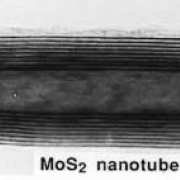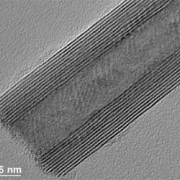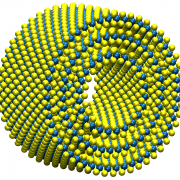During 1990 and 1991 we were preparing thin films of WS2 and MoS2 for photovoltaic applications and we studied their detailed structure using scanning and transmission electron microscopy and other techniques. During these investigations our electron microscopy expert Dr. Lev Margulis started to see hollow nanostructures which he designated as “red blood cells”- which were in fact the first images of the fullerene-like WS2 nanoparticles (see the envelope with TEM film negative in Fig. 1a) and the nanotubes (the negative’s envelope shown in Fig. 1b). It took us a few more months to understand the importance of these early TEM pictures.
In 1992 (No. 91) we showed that nanoparticles of the layered compound WS2 are unstable in the platelet form and they spontaneously form closed cage structures akin to carbon fullerenes and carbon nanotubes. This instability was attributed to the highly reactive dangling bonds of both sulfur and tungsten atoms, which appear at the periphery of the nanoparticles. We therefore proposed that this instability is generic to compounds with layered structure and consequently named this nanostructures, inorganic fullerene-like (IF) structures and inorganic nanotubes (INT)- see Figs. 2 to 3. Following the elucidation of the growth mechanism of IF and INT of WS2 (MoS2) in great detail (see for example No. 149), we were able to scale-up their synthesis using the fluidized bed reactor. This work was followed by a series of works in which fullerene-like nanoparticles and nanotubes of various other layered compounds, like NiCl2 (No. 132- see Fig. 4) and other metal-dihalides and oxides, like IF-Cs2O with anti-cadmium chloride structure (No. 197).
|
(Fig. 1a) |
(Fig. 1b) |
|
Fig. 2a TEM micrograph of MoS2 nanotube taken by the late Dr. Lev Margulis. See reference No. 104. |
Fig. 2b TEM micrograph of a WS2 nanotube. Image courtesy of Dr. J.L. Hutchison and Dr. R. Dunin-Borkowski, Oxford University, UK. See reference No. 91. |
|
Fig. 3. Three-layer model of WS2 nanotube. Image courtesy of Prof. T. Heine, Jacobs University, Germany.
|
Fig. 4. TEM image of NiCl2 nanotube. See reference No. 132.
|








